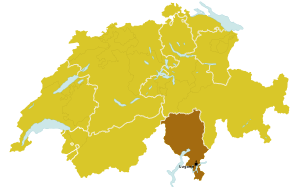Diocese of Lugano
| Diocese of Lugano | |
| Basic data | |
|---|---|
| Country | Switzerland |
| Ecclesiastical province | Immediate |
| Diocesan bishop | Valerio Lazzeri |
| Emeritus diocesan bishop |
Ernesto Togni Pier Giacomo Grampa |
| Vicar General | Ernesto Storelli |
| founding | 1971 |
| surface | 2,811 km² |
| Parishes | 256 (December 31, 2011 / AP 2013 ) |
| Residents | 317,000 (December 31, 2011 / AP 2013 ) |
| Catholics | 241,000 (December 31, 2011 / AP 2013 ) |
| proportion of | 76% |
| Diocesan priest | 203 (December 31, 2011 / AP 2013 ) |
| Religious priest | 54 (December 31, 2011 / AP 2013 ) |
| Catholics per priest | 938 |
| Permanent deacons | 6 (December 31, 2011 / AP 2013 ) |
| Friars | 61 (December 31, 2011 / AP 2013 ) |
| Religious sisters | 379 (December 31, 2011 / AP 2013 ) |
| rite | Ambrosian and Roman rites |
| Liturgical language | Italian and Latin |
| cathedral | San Lorenzo |
| Website | www.catt.ch |
The Diocese of Lugano ( Latin : Dioecesis Luganensis ) is a diocese of the Roman Catholic Church located in Switzerland . It covers the area of the Canton of Ticino .
The seat of the bishop is Lugano and the Cathedral of San Lorenzo there . The patron saint of the diocese is St. Charles Borromeo together with St. Abundius and Ambrose . In around 50 parishes in the diocese, mass is celebrated according to the Ambrosian rite .
history
From the end of the 9th century, the area of what is now the canton of Ticino was partly subordinate to the Archdiocese of Milan and partly to the Diocese of Como . With the independence of the canton in 1803, the need for an own diocese increased , but this failed due to the resistance of Austria. The conservative government of Austria feared that the Catholic Church in Ticino could come under the influence of the liberal Ticino government. The situation only changed after the establishment of the Kingdom of Italy in 1861. After a treaty between the Swiss Confederation and the Vatican in 1884, the Ticino parishes were separated from the dioceses of Como and Milan and in the person of Eugène Lachat, previously Bishop of Basel had been subordinate to an Apostolic Administrator . Lachat reached Ticino on August 10, 1885 and died on November 1, 1886.
Under the administration of Vincenzo Molo, Archpriest of Bellinzona , Pope Leo XIII received the Bull Ad universam . the diocese of Lugano was founded on September 7, 1888. It remained formally subordinate to the diocese of Basel as the Apostolic Administration , and the Bull Ad universam carefully avoids the term diocese in order to respect the prohibition of the establishment of new dioceses in the Swiss Federal Constitution .
On March 8, 1971, the Apostolic Administration of the Canton of Ticino was officially separated from the Diocese of Basel and the administrator Giuseppe Martinoli was given the title of Bishop of Lugano. The new status of the diocese was sealed on April 25, 1971 with a solemn mass in the Cathedral of Lugano.
Ordinaries

Apostolic Administrators
- 1884–1886: Eugène Lachat
- 1887-1904: Vincenzo Molo
- 1904–1916: Alfredo Peri-Morosini
- 1917-1935: Aurelio Bacciarini
- 1936–1968: Angelo Jelmini
- 1968–1971: Giuseppe Martinoli
Bishops
- 1971–1978: Giuseppe Martinoli
- 1978–1985: Ernesto Togni
- 1986-1995: Eugenio Corecco
- 1995-2003: Giuseppe Torti
- 2004–2013: Pier Giacomo Grampa
- 2013– : Valerio Lazzeri
See also
Web links
- Antonietta Moretti: Lugano (Diocese). In: Historical Lexicon of Switzerland .
- Website of the Diocese of Lugano
- Entry on Diocese of Lugano on catholic-hierarchy.org
- Diocese of Lugano on gcatholic.org
Individual evidence
- ^ Antonietta Moretti: Lugano (diocese). In: Historical Lexicon of Switzerland .

